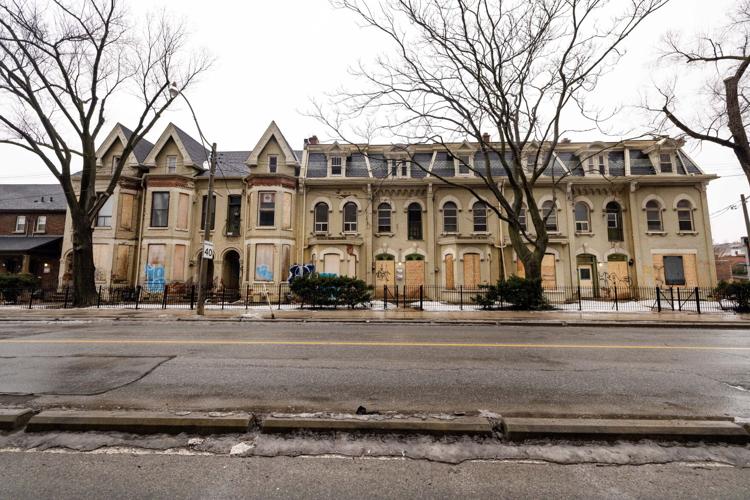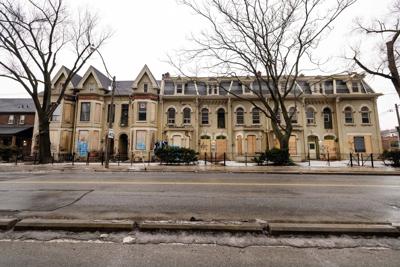If you look for signs of life at a decaying block of once-grand row houses on Wellesley Street, you’ll find little more than a pigeon. The beady-eyed bird has made its nest upon an upper window — the higher panes not yet boarded up with plywood like the lower ones, among graffiti flashes and crumbling brick.Ìý
This elegantly designed bay-and-gable building, with vines carved into the facade and arched brick entryways, has become a skeleton in the streetscape. Inside, moisture, rot and termites have laid siege to the floors, walls and windowsills, and vegetation has taken root in the dirt basement floors.Ìý
“I was looking at this and really just clenching my teeth. Why don’t they fix this up?” said 65-year-old Anthony Gulyas,Ìýstanding outside one recent afternoon. Gulyas once lived in the building, which most recently operated as a city-subsidized rooming house, and now lives across the road.Ìý
These row houses, on prime land in the downtown east neighbourhood of Cabbagetown—South St. James Town, are in limbo. The homes were breaking down even before 2018, when city hall decided to hand hundreds of rooming houses and smaller public housing sites to non-profit groups.ÌýTheseÌýparticular row houses, however, needÌýa rehabilitation plan before they change hands.
AndÌýthere is no plan yet.
After moving the last tenants out last year, with more than a dozen displaced over a five-year process, city hall says it has hired an engineer to assess the damage over the coming months. The list of needed repairs on-site is expected to be “extensive,” and city hall says any future plan must consider the site’s heritage status, meaning any changes must respect its architectural history.
So, for now, it sits empty, despite an affordability crisis outside its doors and more than 100,000 households on the city’s housing waitlist.
From grand home to rooming house
The Wellesley building, believed to date back to 1878, has been the backdrop to a colourful history. In 1909, if you came at the right time, a resident advertisedÌýtheir “prize-bred” greyhounds for sale inside. In 1944, two residents took to the Star to invite their “many friends” to a large anniversary bash.ÌýResidents lived comfortable lives, advertising for domestic help to keep their homes neat and clean. But these well-to-do days didn’t last the century.
Over time, it became a landing place for thoseÌýjust barely scraping by. By the 1990s, the site was overseen by public housing landlord Cityhome, and some tenants complained about a growing number of residents clearly struggling not only with poverty, but with challenges like substance use without supports.

The homes, built in the late 1800s, were once grand homes. They were most recently used as publicly run rooming houses.
Andrew Francis Wallace º£½ÇÉçÇø¹ÙÍøSAs residents struggled, the building did too, falling into growing disrepair. After amalgamation in 1998,Ìýthe newly formed º£½ÇÉçÇø¹ÙÍøCommunity Housing Corp. (TCHC)Ìýstruggled with how to pay for desperately needed repairsÌýacross its portfolio, and many sites languished in poor shape.
Still, the row houses provided a roof overhead to some of the city’s lowest income residents well into the new millennium. For Gulyas, it was a safety net. He became homeless in the 2000s after a relationship breakdown, and found himself relying on a bed in a large emergency shelter on Sherbourne Street. Shoving in the hallways left him on edge and searching for a wayÌýout.
After a short stay at another rooming house nearby, Gulyas was offered a bedroom with subsidized rent inside the Wellesley building. He’s frank about it being a challenging setup. “It was a tight rooming house. All kinds of people lived here, and there were a lot of social issues going on,” he said. It was loud and its physical condition was deteriorating, presenting problems such as mould and floodsÌý— with the mould becoming bad enough that he convincedÌýhousing officials toÌýtransfer himÌýto a highrise across the street.
But for all its faults, the basement bedroom was a step on the ladder.
“If I hadn’t gotten into º£½ÇÉçÇø¹ÙÍøhousing, I’d literally be screwed,” he said.
‘I don’t know why they’re sitting on this’
Shortly after Gulyas left, conversations began swirling at city hall about the future of public housing sites like these. UnderÌýa plan approved in 2018, city hall decided TCHC would relinquish its rooming houses, as well as many other scattered properties, to non-profit organizations, co-ops and community land trusts. The idea was that non-profits had more expertise with small sites, and could offer more individualized supports to tenants with complex needs. The plan also helped claw away at TCHC’s repair backlog and future cost demands.Ìý
Given the depth of repair problems on Wellesley, with tenants staying next to alreadyÌýunlivable units boarded up and vacant, officials decided to empty the site entirely in order to assess and repair it before the transfer. The process of emptying the site took five years, with TCHC pointing to COVID-19 as one factor, as well as challenges in finding alternate housingÌýfor tenants. Most who remained as of 2022 were moved into other public housing properties, while one moved into a senior-specific housing site and one left public housing altogether, their fate unclear from the information shared with the Star.

The homes have been deteriorating, with mould and termites among other issues.
Andrew Francis Wallace º£½ÇÉçÇø¹ÙÍøSWith the property now vacant, city hall says its engineer will now take a look at features like the roof, walls, foundation and windows.ÌýPast TCHC assessments already documentedÌý“major” termite and water damage; rotting windowsills, floors, floor joists and interior walls; “moisture and vegetation issues” in the dirt-floor basements; and damage to the roof, foundation and masonry.
City hall says the building’s heritage statusÌýadds a layer of complexity to any renovation plans. This priorityÌýhas been met with some ire. Affordable housing advocate Mark Richardson argues maintaining the heritage elements should be less important than reopening sorely needed low-cost rentals.
“We’re saying the outside of those buildings, and the history of those buildings, is more important than what could and should be delivered on that land today to solve our actual crises in 2025,” Richardson said of the site.
Gulyas is under no illusion that reopening the Wellesley row houses will solve Toronto’s woes. “We need so much housing, and we’re so backlogged in housing all across Canada, that even if they fix this up, it wouldn’t even be a dent. It wouldn’t even be a drop in the ocean of what we need,” he said.Ìý
But in the face of so much need, he sees it sitting empty as a shame.
“I don’t know why they’re sitting on this,” he said.































To join the conversation set a first and last name in your user profile.
Sign in or register for free to join the Conversation